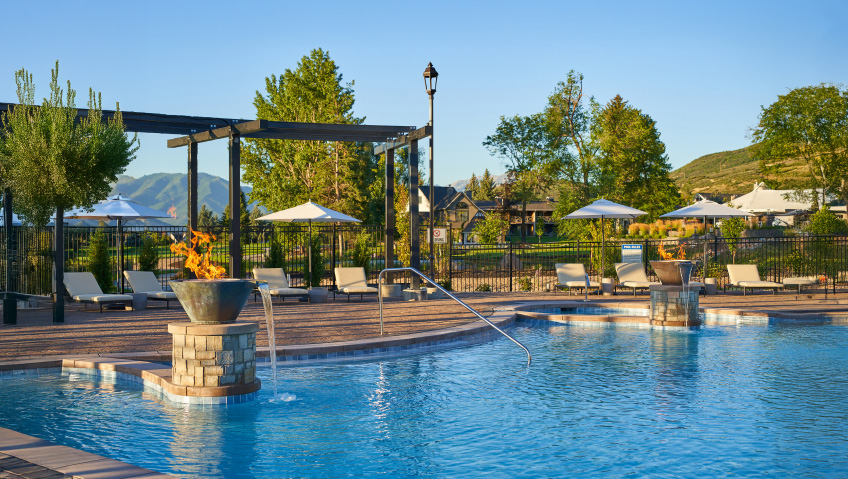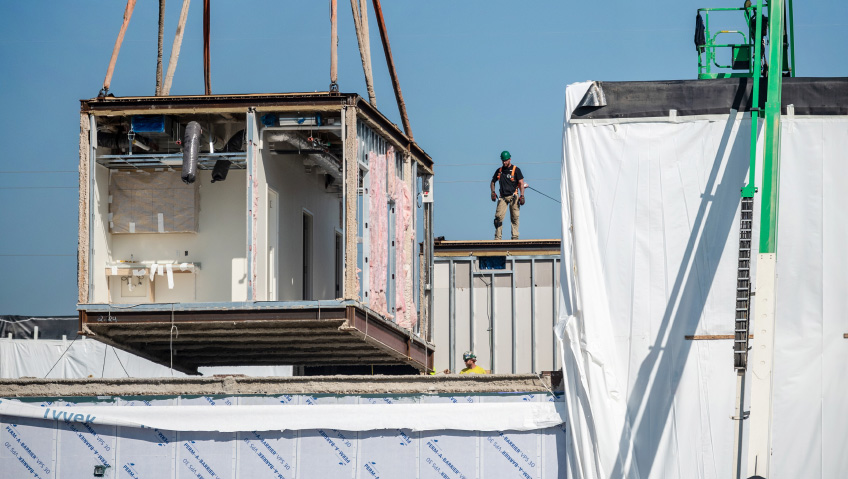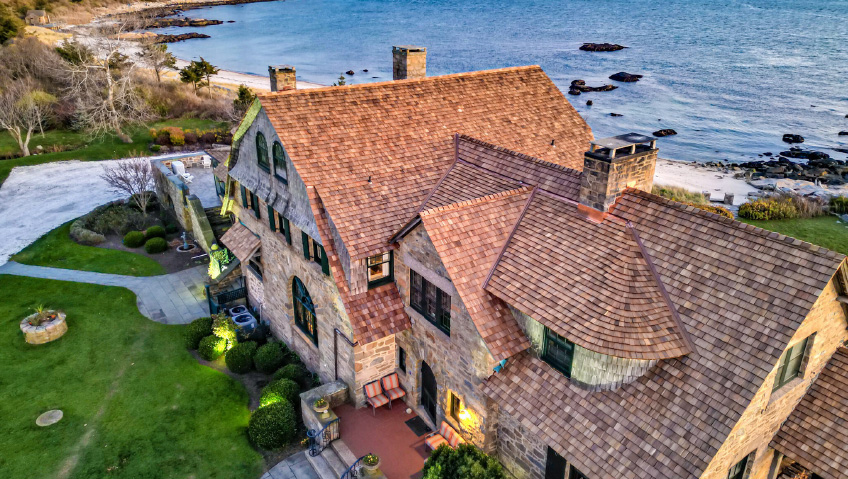This spring, staff from Cloward H2O—a leading aquatics engineering firm from Lindon, Utah—got to enjoy the fruits of their labor at the Glenwood Hot Springs Resort in Colorado. Cloward H2O engineers had modernized and updated the Glenwood site a few years prior, a massive undertaking detailed in September 2024’s Construction in Focus.
So that was how, in May of this year, Cloward H2O personnel returned to Glenwood for Hot Springs Connection, the official conference of the Hot Springs Association. Between seminars, attendees took time to relax and enjoy the storied waters of the historic facility, which first opened in the 19th century.
“It was a unique opportunity for us to experience firsthand some of our creations,” says Dan Aldred, Associate Principal and engineer at Cloward H2O. “We designed three distinct waterfalls, each offering a different sensory experience—and all three perform beautifully. One falls with a thundering roar, like you’re standing under Niagara. Another creates a very light, silky texture that feels good when you put your neck and hands in it. The third is a quiet trickle that slips gently down a wall—you barely feel it until you lean your back against the stone.”
Masters of aquatic engineering
Working closely with architects, developers, and designers, Cloward H2O handles the engineering responsibility for pool structures and ancillary mechanical systems alike. The company’s services include conceptual design and planning, water treatment and circulation engineering, structural engineering, power distribution and controls, hydraulic analysis and modeling, aquatic life support design, and more.
Cloward H2O works on swimming pools, waterparks, splash pads, whitewater rafting sites, fountains, aquariums, large lagoons—essentially all things recreational water. The company handled around 90 projects last year, primarily for the hospitality and resort markets, with around half of them outside the United States.
Since our previous profile, Cloward H2O has opened a new satellite office in Colorado, expanded its workforce, enhanced its skills, and received recognition for its work. This summer, for example, Aquatics International magazine announced Montgomery Whitewater as a 2025 Dream Design. Cloward H2O worked extensively on Montgomery Whitewater, which covers 120 acres in Alabama and features manmade channels for whitewater rafting and kayaking.
The facility’s whitewater course was “built to Olympic standards,” says a July 9, 2025, post on the Aquatics International website, which also praises Cloward H2O’s engineering acumen. “The project was unique and presented a lot of really great engineering challenges. It was fun to overcome them and great to be recognized for that work,” says Associate Principal and Engineer Rob Cloward, son of company founder Greg Cloward and brother of current President/Principal Corry Cloward.
The latest and greatest
In terms of ongoing work, artificial lagoons are a burgeoning trend. These bodies of water can be compared to oversized swimming pools. “We have several of these in development right now,” says Cloward. “Instead of building a community around a golf course, a lot of developers are building these communities around a lagoon.”
These man-made bodies of water function like swimming pools on a grand scale—but with the size, beauty, and recreational variety of a natural lagoon. Continuous filtration and water-quality management keep conditions swimmer-safe. Some developers complement lagoons with retail stores, hotels, additional pools, and other amenities, adds Aldred.
Stainless steel and concrete remain the primary materials the company works with when engineering its water features for the construction teams, but Cloward H2O also employs specialized liners for lagoon developments and granite or precision-cut stone for specialty pools and fountains, along with a variety of finishes including plaster, tile, and other safety coatings, with the team maintaining a keen focus on following developments in waterproofing materials and technologies. “There are a lot of great additives that they’re putting in concrete coatings, and they also have a lot of polymer coatings. We look at new technologies and construction materials regularly to see what might improve a project’s efficiency, integrity, and long-term value to the client,” notes Aldred.
In addition, water facilities are increasingly sporting sensors, elaborate lighting systems, wireless networks, and Internet of Things (IoT) connectivity. These systems can be used to adjust lights, water flow, and water temperature using an iPad or other computerized controls. Given these developments, clients are increasingly requesting “bigger and better effects—more waterfalls, water shooting up higher, water flowing in different directions,” says Project Manager and Engineer Zach Robinson.
It’s Cloward H2O’s job to accommodate such demands whenever possible. At times, the company needs to remind customers about some basic principles: “The first rule is, we have to obey the laws of physics. As long as we can obey the laws of physics, let’s see what we can do,” says Robinson.
The possibilities are impressive as technology keeps advancing. Cloward H2O is currently working on a project that involves “an articulating robot, basically an eyeball if you will, that will shoot water and be able to control the flow of water and move it around. Pair that with lights, you get really cool effects,” notes Robinson.
Behind the scenes, Cloward H2O continues to use 3D modeling software and computational fluid dynamics (CFD) technology. The 3D software gives the team a better impression of what a proposed design will look like while CFD technology forecasts the flow of water and other fluids. Ironically, 3D software solutions generate so much data that Cloward H2O has to carefully limit the information passed on to the client so as to keep them informed but not overwhelmed.
It all starts with the soil
Cloward H2O matches these high-tech tools with common-sense guidance. Before anything gets built, the firm conducts a geotechnical survey to analyze the soil conditions at potential building sites.
“The structural engineer bases all their calculations upon these soil conditions,” Aldred explains. “I’m working on a project now—a fairly good-sized waterpark in Manila, Philippines—and the site had poor soil and high water tables. So, nearly the entire site was built on piles to provide the structural integrity for all the pool shells, slide towers, and buildings that will be placed on top of it.”
Modular construction, in which segments of a building are put together in factories, shipped to building sites, and then assembled, is gaining momentum throughout the world, but within the aquatic engineering world, these methods have been reliably used for decades with prefabricated fiberglass or stainless-steel pools. Large segments of a stainless-steel pool “can be shipped out and craned into place, and then piped up and installed within about three days,” says Robinson. Cloward H2O is currently working on some swimming pool projects that also entail the use of prefabricated concrete.
Modular methods can drastically shorten construction times and provide contractors with more control over the building process. The downside is a lack of flexibility; wild shapes and unusual pool designs “are not applicable for the pre-cast world. But if you just want a basic square or rectangle, it might be a really good option for you,” says Aldred.
Part of something great
With engineering at the core of what Cloward H2O does, new applicants must, of course, be technically proficient. But beyond that, “I like looking for soft skills,” says Cloward. “I want to see people with good, solid work ethics, who want to be part of creating something great, who show up on time and think the process through—who understand that what they do impacts other disciplines, and who understand how they fit into the bigger picture.”
Integrity, morals, and communication skills are also valued. If problems occur during a project, staff are expected to be upfront and honest with the client, even if the news is upsetting, adds Aldred.
This same dedication to integrity underlines Cloward’s participation in industry efforts to set NSF and ASTM standards for its sector. Established in 1944 as the National Sanitation Foundation, the NSF establishes safety, health, and design benchmarks for everything from food and beverages to waterparks and pools. ASTM International, meanwhile, is a renowned organization that has set approximately 13,000 quality standards in a variety of fields.
Promotion-wise, Cloward H2O plans to display a new booth at the International Association of Amusement Parks and Attractions (IAAPA) conference in Florida this November.
“For about six years, we’ve used our old booth, but this year we’re excited to unveil an entirely new one,” says the Business Development Manager, Jacob Clawson. “The new booth features a screen showcasing videos of our projects—most of which can also be found on our YouTube channel—along with one exclusive video highlighting one of our most unique and technically complex projects to date. It’s exciting to finally share that at the event, along with the interactive whitewater model that was unveiled at last year’s show. Overall, it’s a bigger and better display of our work. But beyond the visuals, the main goal of IAAPA is to connect with our clients and partners, so we’ve designed the space to encourage collaboration and meaningful conversations.”
Solving problems nobody knew existed
Going forward, the company plans to stick to its core competencies while enhancing existing skills and augmenting its post-design construction support services. Including a post-design construction support phase in a project “gives the contractors and those on site the ability to ask questions about our design and to clarify and help solve problems that nobody knew existed. We like to call it the owner’s insurance policy on the design,” says Robinson.
Other company goals include becoming “a little smarter, a little wiser” and growing the staff, says Cloward.
“It would be great if we could open one or maybe two more satellite offices; it would help extend our reach around the globe a little better,” adds Aldred. “But we don’t want to grow too fast. Overall, another 10 to 20 percent on our staff would be wonderful.”






